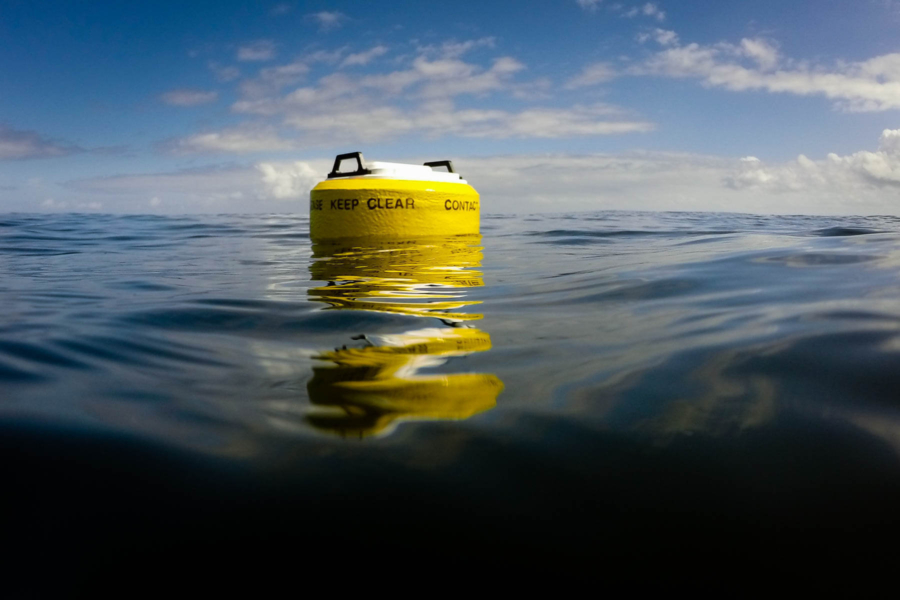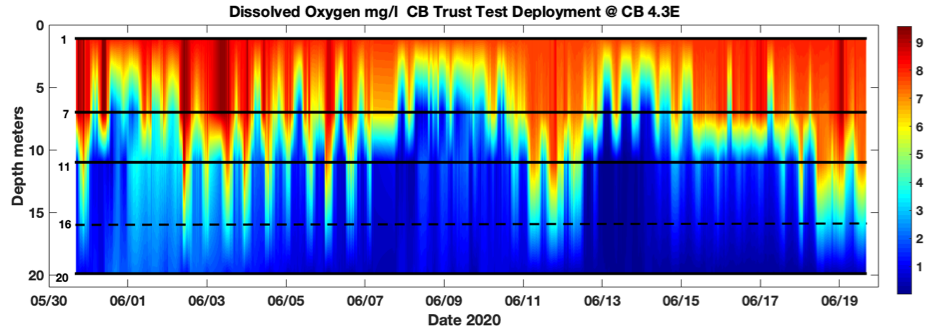Taking a deeper dive on oxygen in the Chesapeake Bay

Living creatures—both on land and in the water—need oxygen to survive. But parts of the Chesapeake Bay often experience hypoxia, a situation where oxygen levels in the water get dangerously low. Hypoxia can result when excess nutrients run off the land into the water and fuel the growth of algal blooms. When these algae die, they sink to the bottom of the water and decompose—a process that uses up a significant amount of the water’s oxygen. These low- or no-oxygen areas are often referred to as “dead zones,” which is an apt name: Extended periods of hypoxia can stress living creatures and lead to die-offs of fish, shellfish and plants.
While scientists understand many of the elements that cause dead zones, they are eager to learn more to help them better predict where and why hypoxia occurs. Currently, computer models can simulate dead zones by using monthly hypoxia profiles that show what dissolved oxygen levels are at a number of water depths (dissolved oxygen is the amount of gaseous oxygen dissolved in the water). These profiles help scientists create a three-dimensional estimate of where low-oxygen areas will be. Resources like the Virginia Institute of Marine Sciences (VIMS) Chesapeake Bay Hypoxia Forecast and monthly hypoxia reports like those from the Maryland Department of Natural Resources (DNR) provide data for these simulations, but acquiring that data is a constant challenge. DNR’s reports rely on monitoring cruises that can be affected by weather or other safety considerations. And only a few observing stations on the Bay track dissolved oxygen levels—and do so only near the water’s surface.
But new technology can provide a boost. To more fully understand how dissolved oxygen levels vary throughout the water, from the surface to the bottom of the Bay, the Chesapeake Bay Program’s Sustainable Fisheries Goal Implementation Team and the Scientific, Technical Assessment, and Reporting Team are funding a project to test equipment that could continually track dissolved oxygen at key locations throughout the Bay to assist with hypoxia modeling. Monitoring changes in dissolved oxygen levels and analyzing these changes along with information on how different fish use the Bay will allow scientists to evaluate the effects hypoxia has on important resources including striped bass. For example, some fish are good at tolerating low oxygen levels, but others are quite sensitive, and will swim away to try to find better conditions. Oysters are of course attached to the reefs they have built, making them vulnerable to hypoxia that occurs in that area.
Using funding provided by the Environmental Protection Agency, the Chesapeake Bay Trust awarded a contract to Caribbean Wind to develop a small buoy with sensors that measure dissolved oxygen, temperature and salinity at multiple depths. A test buoy was deployed near the mouth of the Choptank River in Maryland earlier this summer for several weeks. The project’s researchers are developing lessons learned about the equipment—and the data it recorded.

The buoy is solar powered and includes a computer that collects the data and then sends it back to a server on shore every 10 minutes—much more frequently than humans are able to collect during monthly scientific cruises. Data were collected at one, seven, 11, 16 and 20 meters below the surface, giving scientists a more comprehensive view of conditions throughout the Bay’s water column—all the way from the surface to the bottom, the water that fish need for habitat.
During the initial test deployment, a few of the sensors didn’t fully operate. Researchers also noticed some issues with fouling at a few of the sensor depths. Fouling is when biological growth, like algae, covers sensors and hampers their operations. With a few changes and improvements made to tackle these issues, a second test deployment is currently under way, slated to run through much of October. If this version of the buoy is successful, others could be developed as a critical tool in helping scientists better predict and understand hypoxia in the Chesapeake Bay, leading to more accurate dead zone forecasting. All of this could help resource managers develop more accurate and targeted regulations, helping to protect species when and where their oxygen levels are most threatened.

Comments
Hey Deborah, thank you for the question. If not properly disposed of, medicine that enters the water can certainly have a negative impact on local streams, rivers and the Bay. The Environmental Protection Agency has guidelines related to disposing medicine: https://www.epa.gov/hwgenerators/collecting-and-disposing-unwanted-medicines. Penn State Extensions also has information related to the topic: https://extension.psu.edu/pharmaceutical-disposal-and-water-quality. Hope this helps!
A hospital where I worked in south central Pa disposes of its unused narcotics down the drain. Will that have an effect on the Bay ?
Thank you!
Your comment has been received. Before it can be published, the comment will be reviewed by our team to ensure it adheres with our rules of engagement.
Back to recent stories